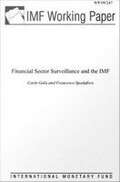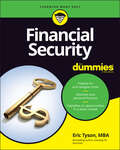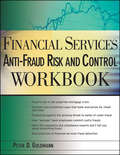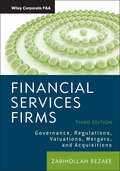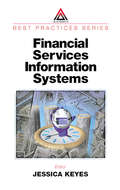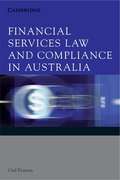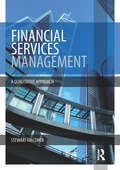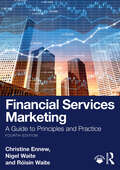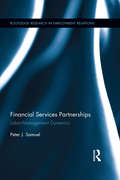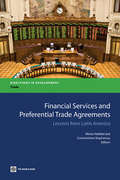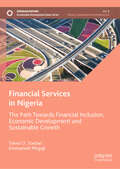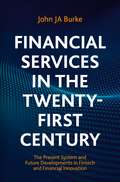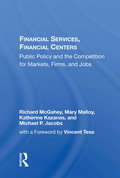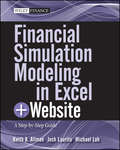- Table View
- List View
Financial Sector Reform and the International Integration of China (Routledge Studies on the Chinese Economy)
by Zhongmin WuChina's economy, which continues to grow rapidly, is having an ever greater impact on the rest of the world. This impact is likely to be felt increasingly in the financial sector where China's foreign currency reserves, fuelled by the huge trade surplus, are a very significant factor in world financial markets. This book, based on extensive original research by a range of leading experts, examines many key aspects of current reforms in China's financial sector and China's increasing integration into the international economy. Subjects covered amongst many others include: the derivatives market in China; stock market liberalisation; the internationalization of accounting standards in China; the impact of international foreign direct investment by Chinese firms; and a discussion of the likely long-term economic effects of the Beijing Olympic Games.
Financial Sector Reforms and Exchange Arrangements in Eastern Europe
by Paul R. Masson Eduardo Borensztein Guillermo CalvoA report from the International Monetary Fund.
Financial Sector Surveillance and the IMF
by Carlo Gola Francesco SpadaforaA report from the International Monetary Fund.
Financial Security For Dummies
by Eric TysonBoost your financial health so you’re ready for any economic or personal upheaval Crisis is inevitable—but it doesn’t have to torpedo your finances! Financial Security For Dummies offers proven advice to help you prep your finances for the next economic downturn, personal setback, pandemic, plague of locusts—or anything else life throws your way. This book contains the historical perspective and up-to-date info you’ll need to anticipate, understand, and navigate a wide range of personal financial challenges. If your monthly income and expenses are on steady ground and you’re ready to secure your financial future, this is the For Dummies guide for you. Not only will you create a plan to keep your family’s finances afloat during turbulent times, but you’ll also be liberated from the pressure to “keep up with the Joneses” so you can make smarter financial decisions, starting today. This book will help you: Gain an understanding of how unforeseen personal or global events could affect your financial life Learn strategies for protecting your assets when economic downturns and other emergencies occur Feel confident in your unique path to financial freedom so you can remain calm when life takes an unexpected turn Build a survival plan for protecting yourself with broader safety nets, better money decisions, and improved financial literacy Whether you want to reduce your stress surrounding your financial goals or take advantage of financial opportunities crises create, Financial Security For Dummies will equip you to navigate financial challenges and ultimately achieve peace of mind.
Financial Security and Personal Wealth
by Lewis D. SolomonAmerica's elderly population is soaring, presenting numerous challenges for policymakers in the United States. Other developed nations with aging populations face similar problems. There will be fewer workers relative to retirees in coming decades and the elderly are also expected to live longer. The impact of these demographic changes in the United States is likely to be challenging, especially for America's system of social security. Solomon offers new perspectives on how to meet the future costs of social security without bankrupting the next generation or gravely damaging the U.S. economy. He also shows, more broadly, how to provide for the financial security of America's senior populations.Over the past two decades, primary responsibility for providing a financially adequate retirement has shifted from the federal government and employers to individuals. For most Americans, social security alone will not provide enough income. Most companies have shed their pension plans for 401(k) plans, to which companies and employees contribute, and in which participants must make their own investment decisions. Consequently, achieving financial security in retirement has increasingly become one's personal responsibility.Solomon deals extensively with the politics of social security, past and present. He examines the presidential leadership of Franklin D. Roosevelt and Ronald Reagan, both of whom revived the nation's spirit in times of crisis, both of whom introduced economic policies that remain controversial to the present day. He also considers in detail contemporary efforts to rethink social security, focusing on fundamental reform of the social security system and the expansion and simplification of employer-sponsored retirement plans and individual retirement arrangements.Richly textured, informed, and informative, Financial Security and Personal Wealth encompasses history, demography, political economy, public finance, social policy.
Financial Security in China
by Dexu HeThis book studies typical issues regarding China's financial security, such as internal and external currency security, herd behavior in bank credit, system risk in the stock market, major risks in the insurance industry, risks related to shadow banking, and real-estate finance security. The book reflects the author's longtime research experience and personal thought. It uses a completely new structure to present useful and targeted-based countermeasures and suggestions, making it a valuable reference resource for those involved in solving China's financial security problems and creating China's future financial security system. It is highly recommended for readers who want to understand the current situation and features of China's financial security.
Financial Security in Troubled Times
by Ric EdelmanIn troubled times, it is only natural to worry about our financial security. That's why now is the time to act -- to preserve your financial well-being, and that of your family, and to ensure your peace of mind.Financial expert and best-selling author Ric Edelman has written this guide to help all of us quickly safeguard our economic lives. Edelman's eight-point action plan -- actions that you can take right now -- will help you protect yourself and your family, as well as your money, your income, your job, your home, your possessions, and your business. You'll learn how to manage the powerful emotions that can cloud your financial judgment, and find the guidelines you need to make the right investment decisions now that will secure your investments today and prepare you for the future.And because it is more important than ever that we be generous in our charitable giving, you will learn the best ways to give, so you can lend support to all our neighbors who are in such dire need of our help.Financial Security in Troubled Times will help all of us face the future, knowing that our financial house is in order and that we are ready to meet the challenges ahead.
Financial Serial Killers
by Bruce Kelly Tom AjamieBy using true tales of thieves, swindlers, and fraudsters at work, Financial Serial Killers illustrates how these perpetrators get their hooks into investors' wallets, savings accounts, and portfolios--and never let go. The worst financial crisis since the great depression revealed that thousands of mom and pop investors had lost millions to so-called Mini-Madoffs. They are the thieves and conmen who had used phony financial acumen to steal investors' money, wipe out savings, and damage lives. Financial Serial Killers reveals the cons--from the grand to picayune--advisers cultivate with their victims--relationships that are essential to the fraud. Take the story of Lillian, the little old lady who invested with Warren Buffett, one of the richest men in the world. After her husband died, she thought her family's treasure of $24 million in stock controlled by Buffett was safe. It was--until a family relative introduced the eighty-nine-year-old grandmother to a pair of unscrupulous insurance agents who convinced her to reinvest her savings in life insurance--decimating her nest egg while padding the agents' pockets. Lillian's story, as well as other accounts of deceit and fraud are the core of Financial Serial Killers. Readers will learn how to better protect their family's wealth and savings after reading this book.
Financial Services Anti-Fraud Risk and Control Workbook
by Peter GoldmannMyth-busting guidance for fraud preventionin a practical workbook formatAn excellent primer for developing and implementing an anti-fraud program that works, Financial Services Anti-Fraud Risk and Control Workbook engages readers in an absorbing self-paced learning experience to develop familiarity with the practical aspects of fraud detection and prevention at banks, investment firms, credit unions, insurance companies, and other financial services providers.Whether you are a bank executive, auditor, accountant, senior financial executive, financial services operations manager, loan officer, regulator, or examiner, this invaluable resource provides you with essential coverage of: How fraudsters exploit weaknesses in financial services organizations How fraudsters think and operate The tell-tale signs of different types of internal and external fraud against financial services companies Detecting corruption schemes such as bribery, kickbacks, and conflicts of interest, and the many innovative forms of financial records manipulation Conducting a successful fraud risk assessment Basic fraud detection tools and techniques for financial services companies, auditors, and investigators Fraud prevention lessons from the financial meltdown of 2007-2008Written by a recognized expert in the field of fraud detection and prevention, this effective workbook is filled with interactive exercises, case studies, and chapter quizzes, and shares industry-tested methods for detecting, preventing, and reporting fraud.Discover how to mitigate fraud risks in your organization with the myth-busting techniques and tools in Financial Services Anti-Fraud Risk and Control Workbook.
Financial Services Firms
by Zabihollah RezaeeIndispensable coverage of new federal regulatory reforms and federal financial issuesAn essential guide covering new federal regulatory reforms and federal financial issuesFinancial Institutions, Valuations, Mergers and Acquisitions, Third Edition presents a new regulatory framework for financial institutions in the post-bailout era.Provides valuable guidance to assess risks, measure performance and conduct valuations processes to create shareholder valueCovers the protection of other stakeholders, including customers, regulators, government, and consumersOffers an up-to-date understanding of financial institutions, their challenges, and their opportunities in the post-Sarbanes-Oxley eraOver the past decade, substantial changes have taken place in the structure and range of products and services provided by the financial services industry. Get current coverage of these changes that have transformed both traditional organizations such as banks, thrifts, and insurance companies, as well as securities providers, asset management companies and financial holding companies with the up-to-the-minute coverage found in Financial Institutions, Valuations, Mergers and Acquisitions, Third Edition.
Financial Services Information Systems
by Jessica KeyesThe calculus of IT support for the banking, securities, and insurance industries has changed dramatically and rapidly over the past few years. Consolidation and deregulation are creating opportunities and challenges never before seen. Unheard of just a few years ago, e-commerce has given birth to new infrastructures and departments needed to suppor
Financial Services Law and Compliance in Australia
by Gail PearsonUp until the global credit crisis in 2008, 'Financial Services' was the fastest growing sector of the Australian economy. This growth has had profound implications for individuals, corporations and government. Following extensive review in the last part of the twentieth century, Australia put in place an overarching system for regulating all financial services, replacing a system that was based on separate regulation of products in individual industries. Focusing on the implications of the new system for retail clients - 'financial citizens' - Financial Services Law and Compliance in Australia provides a comprehensive account of the regulatory structure and a detailed analysis of the legislative framework, including discussion of the new regulatory bodies, the new licensing requirements for those wishing to enter the financial services market and the new obligations for those marketing or offering financial services to the public. This is an essential resource for those working in, and advising on, financial services, for students of financial services law, and for anyone needing to understand this new regime in Australia.
Financial Services Management: A Qualitative Approach
by Stewart FalconerSweeping changes have taken place within financial services over the course of the past thirty years in response to a variety of influences, such as changes in customer attitudes, an evolving regulatory environment, innovations in information technology and the intense level of competition within the sector. In addition, the global financial crisis has had a huge impact on the perceptions of stakeholders and on the reputations of organisations operating in financial services. This new textbook introduces management with a focus on concepts, theories and skills particularly suited to the financial services sector. Beginning with an overview of the development of management theories through history, the text then focuses on topical issues such as organizational design, the use of information technology, the development of a marketing orientation, social responsibility, ethics and, the influence of the external business and social environments and organizational development and the management of change. This practical textbook mixes theory with application throughout - employing a variety of case studies and examples to render the topic both accessible and memorable. The result is a resource that will help lecturers teaching management skills and students keen to develop their financial services understanding.
Financial Services Marketing: A Guide to Principles and Practice
by Christine Ennew Nigel Waite Róisín WaiteThis fourth edition of Financial Services Marketing firmly reinforces the book’s role as a leading global educational resource, combining appropriate conceptual principles with practical insights on how financial products and services are marketed in the real world. The authors draw upon their extensive international experience marketing some of the world’s best known financial brands including Lloyds TSB and Barclays. Readers will gain a firm understanding of how financial products and services work within the commercial, social, economic, governmental, regulatory and environmental context in which they operate.This fully updated and revised edition features: A brand-new chapter devoted to environmental, social and corporate governance Revised coverage of the impact of digital advances in all aspects of business models and marketing practice, including how artificial intelligence (AI) and social marketing are changing financial services and customer experience The latest regulatory developments for safeguarding the fair treatment of customers New and improved case studies that showcase best practice from around the world Upgraded Support Material including new teaching aids and references Financial Services Marketing is essential reading for advanced undergraduate and postgraduate students studying Marketing for Financial Services, Marketing Strategy and Consumer Ethics in Finance. It is also suitable for executive students studying for professional qualifications and executive MBAs.
Financial Services Marketing: An International Guide to Principles and Practice
by Christine Ennew Nigel Waite Roisin WaiteThis new edition balances the theoretical and the practical for advanced undergraduates, those specialising in financial services at postgraduate level, individuals undertaking professional courses such as those offered by the IFS School of Finance, and employees working within the financial services sector. Ennew & Waite draw from global business cases in both B2B and B2C marketing, taking a unique approach in terms of structure by splitting discussion between marketing for acquisition and marketing for retention. This fully updated and revised second edition features: A revised approach to the industry in the light of the global financial crisis, including ethical considerations, consumer confidence issues, and new approaches to regulation New sections on e-commerce and its impact on customer relationships New case studies and vignettes A new companion website to support teaching, including PowerPoint slides, test bank questions, additional cases and cameo video mini-lectures. Financial Services Marketing 2e will help the student and the practitioner to develop a firm grounding in the fundamentals of financial services strategy, customer acquisition and customer development. Reflecting the realities of financial services marketing in an increasingly complex sector, it provides the most up-to-date, international and practical guide to the subject available.
Financial Services Marketing: An International Guide to Principles and Practice (Marketing Ser.)
by Christine Ennew Nigel Waite Roisin WaiteNow in its 3rd edition, Financial Services Marketing offers a balanced and useful guide to the topic that is both conceptual and practical. The authors have drawn from extensive international experience to ensure that this text will resonate with users across the globe. This edition is complemented by numerous international references, examples and case studies featuring companies such as American Express, Direct Line, Barclays, NatWest RBS, Aviva and HSBC. This fully updated and revised edition features: An expanded section on regulation which has international reach and addresses the post-Brexit world Greatly expanded coverage of digital marketing at both the strategic and tactical levels New material on how to improve a company’s trustworthiness and safeguard a culture that is customer-focussed New examples, vignettes and case studies that showcase best practice from around the world B2B and B2C marketing Upgraded PowerPoint support on the companion website Financial Services Marketing 3e will be hugely beneficial to academic students of marketing and finance, as well as essential reading to those industry-based and studying for professional qualifications.
Financial Services Partnerships: Labor-Management Dynamics (Routledge Research in Employment Relations)
by Peter SamuelThe purpose of this book is to evaluate the debate on partnership, using original research data. Samuel provides a novel categorisation with which to synthesise and clarify a highly diverse literature on labour-management partnership, thus helping to refine the contemporary partnership debate. Secondly, he clarifies the circumstances under which ‘effective’ labour-management partnership is possible, while simultaneously elaborating why the achievement of ‘mutual gains’ is highly improbable in a liberal-market context. Thirdly, the book presents an integrated analysis of the interplay between macro-, meso- (industry) and micro-level factors. Fourthly, the research design enables the study to go beyond the case studies to make defendable empirical generalizations at the level of the industry. Finally, it advances a theoretical explanation of labour-management partnerships in ‘liberal market’ economies by bridging two opposing neo-institutional positions in the social sciences.
Financial Services and Preferential Trade Agreements: Lessons from Latin America
by Constantinos Stephanou Mona HaddadThis book fills a large gap in the literature on trade in services. It focuses on the dynamics of trade and investment liberalization in a sector of considerable technical and regulatory complexity-financial services. This volume chronicles the recent experiences of governments in Latin America that have successfully completed financial services negotiations through preferential trade agreements. One of the unique features of this book is the three in-depth country case studies-Chile, Colombia, and Costa Rica-all written by trade experts who led the negotiations of their respective countries in financial services. The authors offer analytical insights into the substantive content of the legal provisions governing financial market opening and the way such provisions have evolved over time and across negotiating settings. The studies describe how each of the three governments organized the conduct of negotiations in the sector, the extent of preparatory work undertaken before and during negotiations, and the negotiating road maps that were put in place to guide negotiators. Additional chapters complement the case studies by examining the evolving architecture of trade and investment disciplines in financial services and how best to prepare for negotiations in this sector. 'Financial Services and Preferential Trade Agreements' aims to provide practical lessons for policy makers, trade experts, and negotiators in developing countries who are involved in negotiating trade in financial services in the context of regional trade agreements. Academics and development practitioners interested in trade negotiations will also find the information valuable.
Financial Services at Falabella (A)
by C. Fritz Foley Agustin M. HurtadoIn 2010, the board and senior management team of Falabella, a leading retailer with operations throughout Latin America, faced choices about what to do with its financial services division. More than 4.5 million customers had CMR credit cards that could be used in Falabella stores, and Banco Falabella competed with other banks by offering personal banking services. The case covers many of the key questions the leaders of the firm faced, including whether to allow credit card holders to use their cards for purchases outside of Falabella stores, whether to develop personal banking services further, and whether to make substantial changes to the strategy or to exit the business. <p><p> The case gives students the opportunity to devise a strategy for the division of a retailer that provides customers with credit.
Financial Services in Nigeria: The Path Towards Financial Inclusion, Economic Development and Sustainable Growth (Sustainable Development Goals Series)
by Emmanuel Mogaji Taiwo O. SoetanThis book presents a holistic picture of Nigeria's financial services landscape. This includes identifying service providers and regulatory bodies, understanding consumer behaviour, and examining the unique challenges faced by Nigerian financial institutions. The book presents up-to-date research on recent developments and regulatory changes within Nigeria’s financial sector, as well as future considerations for how financial services and financial inclusion can play a crucial role in the country’s sustainable economic growth. Combining academic analysis with practical insights, the book takes readers through Nigeria’s key financial services providers, regulators, consumers, marketing strategies and challenges. A core focus throughout is on financial inclusion and the opportunities associated with reaching financially underserved or excluded populations, demonstrating how increasing financial access at a country-wide level aligns with global goals of reducing inequalities and promoting growth. It will have interdisciplinary appeal to scholars, students and professionals working in finance, economics, business, public policy and development studies.
Financial Services in the Twenty-First Century
by John J A BurkeThis textbook covers financial systems and services, particularly focusing on present systems and future developments. Broken into three parts, Part One establishes the public institutional framework in which financial services are conducted, defines financial service systems, critically examines the link between finance, wealth and income inequality, and economic growth, challenges conventional paradigms about the raison d’être of financial institutions and markets, and considers the loss of US financial hegemony to emerging regional entities [BRICS]. Part Two focuses on financial innovation by explaining the impact of the following technologies: cryptography, FinTech, distributed ledger technology, and artificial intelligence. Part Three assesses to what extent financial innovation has disrupted legacy banking and the delivery of financial services, identifies the main obstacles to reconstructing the whole financial system based upon “first principles thinking”: <P><P> Nation State regulation and incumbent interests of multi-national companies, and provides a cursory description of how the pandemic of COVID-19 may establish a “new normal” for the financial services industry. Combining rigorous detail alongside exercises and PowerPoint slides for each chapter, this textbook helps finance students understand the wide breadth of financial systems and speculates the forthcoming developments in the industry.
Financial Services in the Twenty-First Century: The Present System and Future Developments in Fintech and Financial Innovation
by John JA BurkeThis textbook covers financial systems and services, particularly focusing on present systems and future developments. Broken into three parts, Part One establishes the public institutional framework in which financial services are conducted, defines financial service systems, critically examines the link between finance, wealth and income inequality, and economic growth, challenges conventional paradigms about the raison d’être of financial institutions and markets, and considers the loss of US financial hegemony to emerging regional entities [BRICS]. Part Two focuses on financial innovation by explaining the impact of the following technologies: cryptography, FinTech, distributed ledger technology, and artificial intelligence. Part Three assesses to what extent financial innovation has disrupted legacy banking and the delivery of financial services, identifies the main obstacles to reconstructing the whole financial system based upon “first principles thinking”: Nation State regulation and incumbent interests of multi-national companies, and provides a cursory description of how the pandemic of COVID-19 may establish a “new normal” for the financial services industry. Combining rigorous detail alongside exercises and PowerPoint slides for each chapter, this textbook helps finance students understand the wide breadth of financial systems and speculates the forthcoming developments in the industry. A website to serve as a companion to the textbook is available here: www.johnjaburke.com.
Financial Services, Financial Centers: Public Policy And The Competition For Markets, Firms, And Jobs
by Richard McGaheyThis book lays out the forces that necessitate a strategy, shows how the competitive forces are affecting different financial centers and provides a policy framework for strategy development. It is essential for public officials, policy makers, legislators, scholars, and people in business.
Financial Shocks and TFP Growth
by Marcello Estevão Tiago SeveroA report from the International Monetary Fund.
Financial Simulation Modeling in Excel
by Keith Allman Josh Laurito Michael Loh"I've worked with simulation in business for over 20 years, and Allman really nails it with this book. I admit that I own his previous book on structured finance cash flows, but I was surprised by what I found in here. He addresses the fundamental questions of how decision makers react to simulations and his read was very much in accordance with what I've experienced myself. When it came to the nuts and bolts of describing the different types of simulation analysis the book becomes incredibly detailed. There is working code and models for a fantastic array of the most common simulation problems. If you're so inclined, the book very carefully steps through the tricky math needed to really understand the theory behind stochastic modeling in finance. If you're preparing models that include any kind of randomization or stochastic modeling component, this book is a must-read, a tremendous value and time-saver." -- David Brode of The Brode GroupA practical guide to understanding and implementing financial simulation modelingAs simulation techniques become more popular among the financial community and a variety of sub-industries, a thorough understanding of theory and implementation is critical for practitioners involved in portfolio management, risk management, pricing, and capital budgeting. Financial Simulation Modeling in Excel contains the information you need to make the most informed decisions possible in your professional endeavors.Financial Simulation Modeling in Excel contains a practical, hands-on approach to learning complex financial simulation methodologies using Excel and VBA as a medium. Crafted in an easy to understand format, this book is suitable for anyone with a basic understanding of finance and Excel. Filled with in-depth insights and expert advice, each chapter takes you through the theory behind a simulation topic and the implementation of that same topic in Excel/VBA in a step-by-step manner.Organized in an easy-to-follow fashion, this guide effectively walks you through the process of creating and implementing risk models in ExcelA companion website contains all the Excel models risk experts and quantitative analysts need to practice and confirm their results as they progressKeith Allman is the author of other successful modeling books, including Corporate Valuation Modeling and Modeling Structured Finance Cash Flows with Microsoft ExcelCreated for those with some background in finance and experience in Excel, this reliable resource shows you how to effectively perform sound financial simulation modeling, even if you've yet to do extensive modeling up to this point in your professional or academic career.


